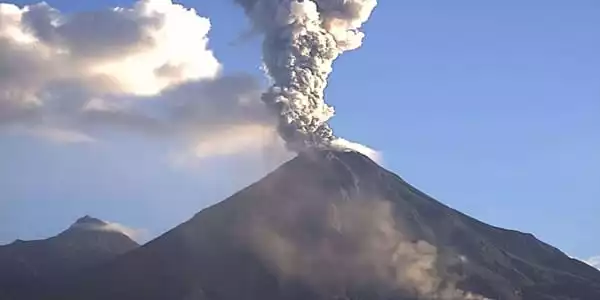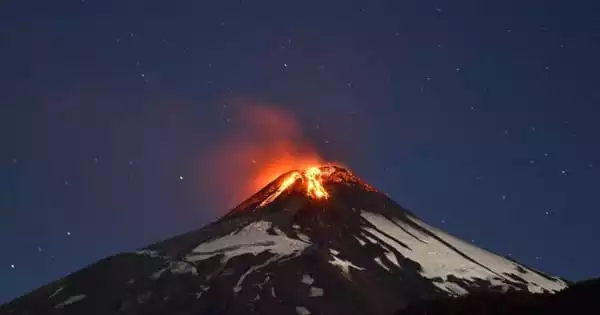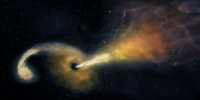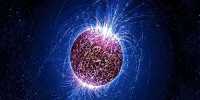A volcano is a rupture in the crust of a planetary-mass object, such as Earth, that allows hot lava, volcanic ash, and gases to escape from a magma chamber below the surface. A volcanic eruption is an awesome display of Earth’s power. Yet, while eruptions are spectacular to watch, they can cause disastrous loss of life and property, especially in densely populated regions of the world. Sometimes beginning with an accumulation of gas-rich magma (molten underground rock) in reservoirs near Earth’s surface, they can be preceded by emissions of steam and gas from small vents in the ground.
In some cases, magma rises to the surface through conduits as a thin and fluid lava, either continuously flowing out or shooting straight up in glowing fountains or curtains. Entrapped gases in other cases rip the magma to shreds and hurl viscous clots of lava into the air. In more violent eruptions, an explosive blast cores out the magma conduit, and solid fragments are ejected in a massive cloud of ash-laden gas that rises tens of thousands of meters into the air.
Scientists have become more adept at monitoring volcanoes in order to predict eruptions in recent years. However, they have difficulty predicting the type and intensity of these events, and there are numerous false alarms.
Lava samples have revealed a new truth about the geological make-up of the Earth’s crust and could have implications for volcanic eruption early warning systems, a new study has found.
A study led by the University of Queensland discovered that lava samples revealed a new truth about the geological make-up of the Earth’s crust, which could have implications for volcanic eruption early warning systems.
Dr Teresa Ubide of UQ volcanology said it was previously thought that cooled lava from so-called ‘hot spot’ volcanoes was ‘pristine’ magma from the Earth’s melting mantle tens of kilometers beneath the surface.
“This isn’t exactly the case – we’ve been misled, geologically deceived,” Dr. Ubide explained. “For decades, we’ve thought of hot spot volcanoes as messengers from the earth’s mantle, providing us with a glimpse into what’s going on deep beneath our feet. However, these volcanoes are extremely complex on the inside and filter a very different melt to the surface than we expected. This is due to the complex plumbing system of the volcano, which forces many minerals in the magma to crystallize.”

According to Dr. Ubide, the minerals are being recycled by the rising magma, changing their overall chemistry to ‘appear’ pristine, which is an important new piece of the puzzle for a better understanding of how ocean island volcanoes work.
“We discovered that hot spot volcanoes filter their melts to become highly eruptible at the Earth’s crust’s base, located several kilometers beneath the volcano,” she said. “Close monitoring of volcanoes can indicate when magma reaches the crust’s base, where the filtering processes reach the ‘tipping point’ that causes eruption. Our findings support the idea that the presence of magma at the crust-mantle boundary could indicate an impending eruption. This new information brings us one step closer to improving monitoring of volcanic unrest in order to protect people, infrastructure, and crops.”
Some of the world’s most beautiful landscapes are made up of hot spot volcanoes, such as the Canary Islands in the Atlantic and Hawaii in the Pacific. The international research team examined new rock samples from the island of El Hierro in Spain’s Canary Islands, just south of Morocco. This data was combined with hundreds of published geochemical data from El Hierro, including the 2011 and 2012 underwater eruptions.
The team then tested the findings on data from ocean island hot spot volcanoes around the world, including Hawaii.
According to Dr. Ubide, hot spot volcanoes can also be found in Australia. “South-east Queenslanders would be very familiar with the Glass House Mountains or the large Tweed shield volcano in New South Wales, which includes Wollumbin (Mount Warning),” she said.
“Hot spot volcanoes can appear ‘anywhere,’ as opposed to most other volcanoes that form as a result of tectonic plates colliding, such as the Ring of Fire volcanoes in Japan or New Zealand, or as tectonic plates moving away from each other, such as the Atlantic Ocean.”
Hot spot volcanoes in southeast Queensland were active millions of years ago. They produced massive amounts of magma and serve as excellent laboratories for studying the origins of volcanism. Even in South Australia, there are dormant volcanoes that could erupt with little warning and would benefit from better geological markers for early detection.”
















